
Small town New York by Booth
After leaving Steamtown and Scranton, I was North-bound on Interstate 81, out of Pennsylvania and into Upstate New York. While the nap I had on the train (!) was nice, by near five in the afternoon I was feeling the length of the day. I stopped at a New York Visitor's Center just over the state line and got one of those guides with motel listings, choosing one in Johnson City, near Binghamton. When I later got back to the book, I discovered that Dreiser had stopped in Binghamton. "Well, I guess I know where I'm going, after all," I thought.
Perhaps Binghamton has something to recommend it. I can't say, as I really didn't see it. The municipalities that I saw were, I suppose, as Dreiser observed about Scranton: " . . . no worse than many another American city of the same size and class that I have seen . . ." Johnson City, what little I saw of it, and Vestal which I drove through the next morning after breakfast, were contemporary cities, as can be seen here:
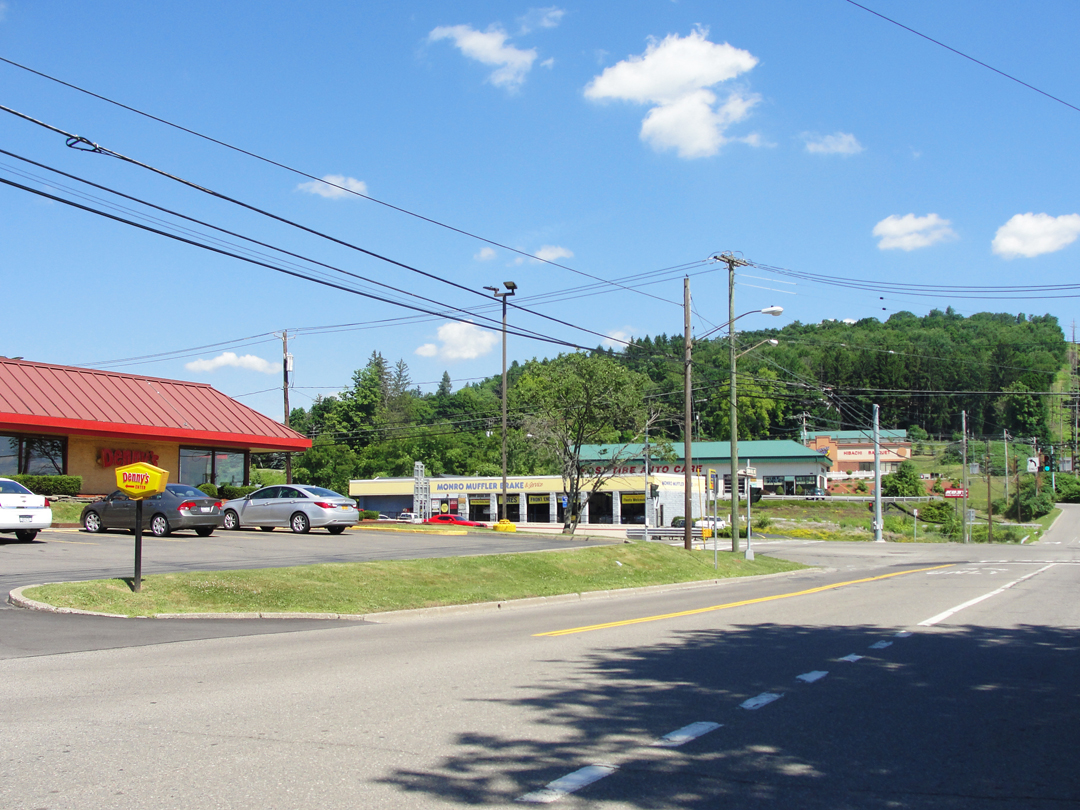
Leaving Denny's I thought, "Why not take a photo?" It's a pretty representative illustration of Middle America - anywhere this side of Kansas, and any time in the last 25 years. I say anywhere this side of Kansas since the last time I was in Kansas or points much West of there woody hillsides like this were rare, but not uncommon from Missouri on East. Likewise, the ubiquitous Dunkin Donuts and Lowe's Home Improvement Center along the road where the land is "Zoned Commercial" :

Yep, acres upon acres of retail and blocks of small office space.
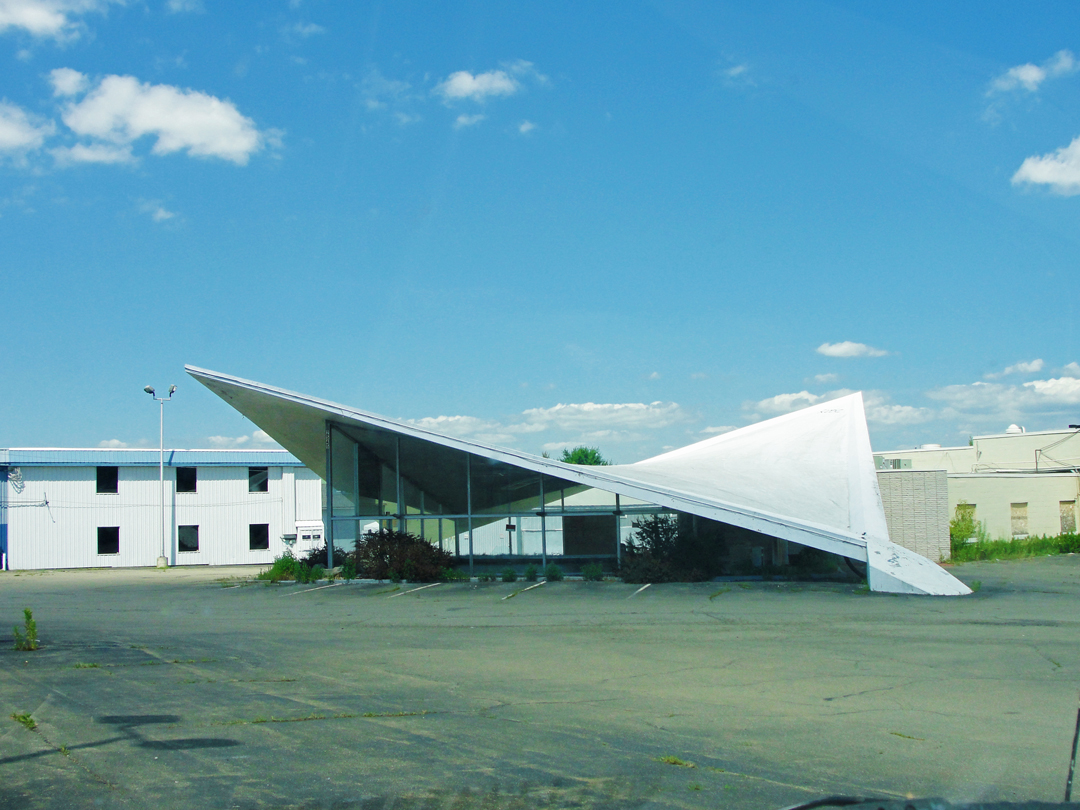
This bit of Mid-Century Modern is, or was, for sale, and I went back to take the photo. More than likely, it will get bulldozed for some new "box" store.
Eventually I drove out of the retail strip, and paralleled the Susquehanna River for a few miles. I may have unconsciously recalled that Dreiser, Booth, and Speed made their drive through Elmira and Corning, or it just seemed a likely turn off the highway, but either way, Elmira was my next pause on the way.
Of Elmira and Corning - the towns themselves - Dreiser recounts little. His text is more ruminative concerning the populations that lived in or around them. In Elmira the local automobile club man exhorts the trio to a direction that would land them in Avon, NY, where " . . . you strike one of the best hotels anywhere . . . walk into the restaurant and ask 'em to give you some of their chicken and waffles. " Dreiser goes on: "I fancied I could see the cloven hoof of the Avon hotel keeper mystically present in that speech . . . a chicken in one hand, a plate of waffles in the other -- but he didn't appeal to me at all."
In Corning, Dreiser and Booth contemplated what makes it possible to pick out Americans of the countryside:
"I tried my best . . . to formulate to myself what it is about these interesting individuals . . . dressed in those peculiarly new and store-y clothes that makes them so appealing and so pathetic to me . . . the red-cheeked, wide-eyed boy in the new brown suit and twentyfive [sic] cent hat looking at people as if all the world and its every gesture were a surprise, and the women walking about streets impossible, one must say, from a social and intellectual point of view, trying to look as if they had something to and some place to go."
Elmira seemed to me a little wheezy and run down. Again, it was the Saturday of a three day holiday weekend, so maybe the energy had gone elsewhere, but what I saw as I made a couple of loops about a few neighborhoods had the feel of a place that was not so much benighted, but benignly neglected. I had the impression that people cared about their town, but that there just weren't the resources, perhaps, to put it "back on the map." The city hall, pictured below, appeared a bit grandiose for the immediate neighborhood --
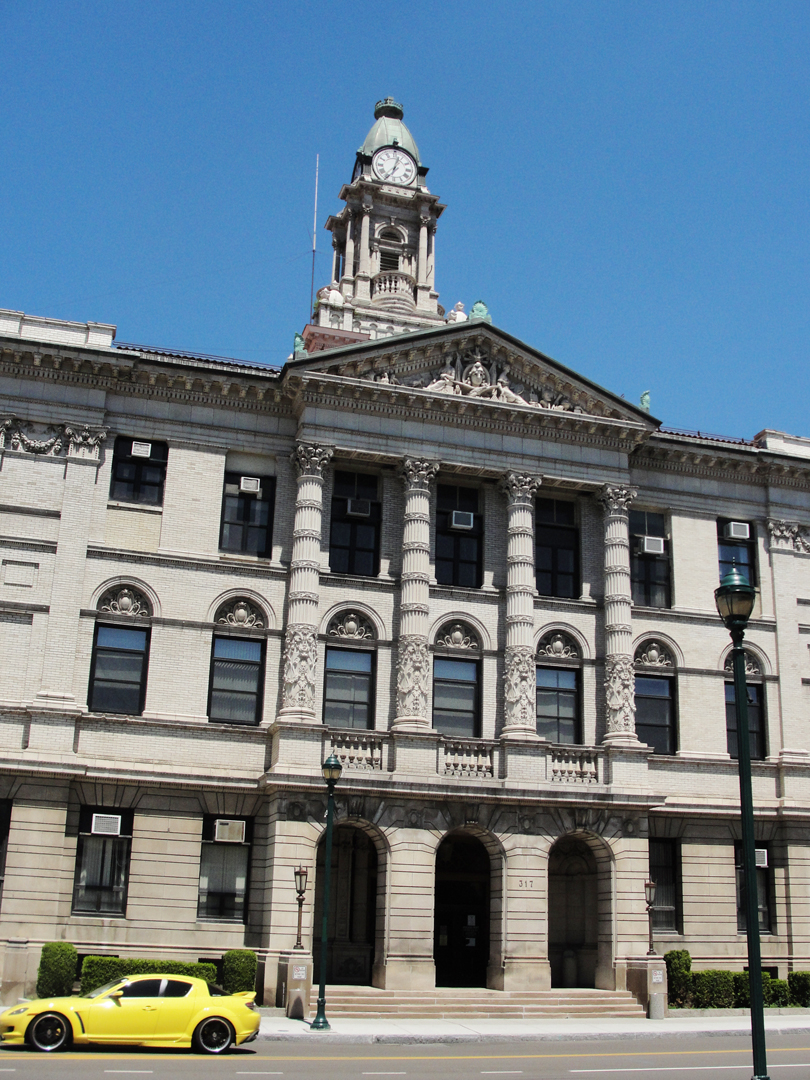
-- because the immediate neighborhood had that air of neglect when the retail and other commerce has moved to the edge of town, leaving the grand old stone piles with not so much reason to exist except inertia and gravity compel them to remain.
WNYC's Radiolab has a story concerning people who don't leave towns. In the episode "Cities," one story was about Centralia, PA, the town that sits atop old coal mines - coal mines that are on fire. 11 people still lived there when the story was produced, down from several thousand. Mary Lou Goughin was interviewed as a near life-long resident of Centralia. She was there when the fire started, and had no interest in leaving. While tangential at best to this road trip, the story bares hearing.
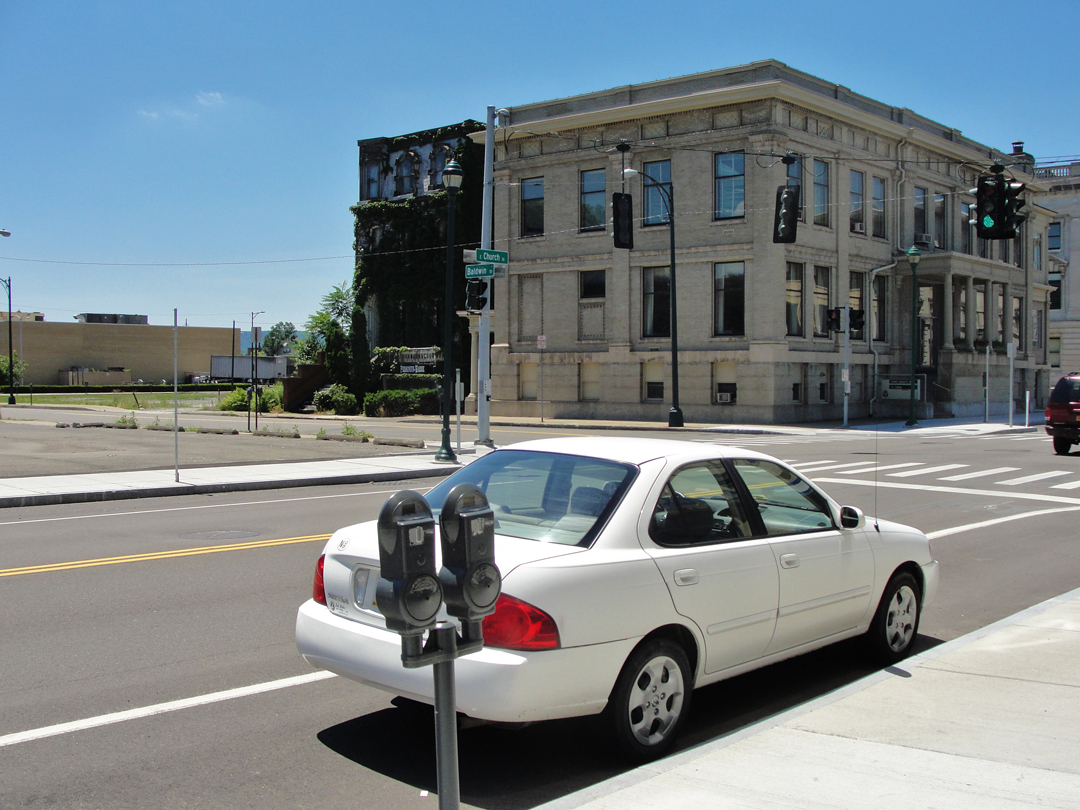
Again, though, I was only "passing through," and it's quite possible that weekdays in Elmira are a-bustle with activity.

Similarities still: Booth's drawing of the land and the following photo 99 years later
I shortly passed on to New York Highway 352, which winds between steep, leafy hills, where crops were a-bustle with mid-summer growth:

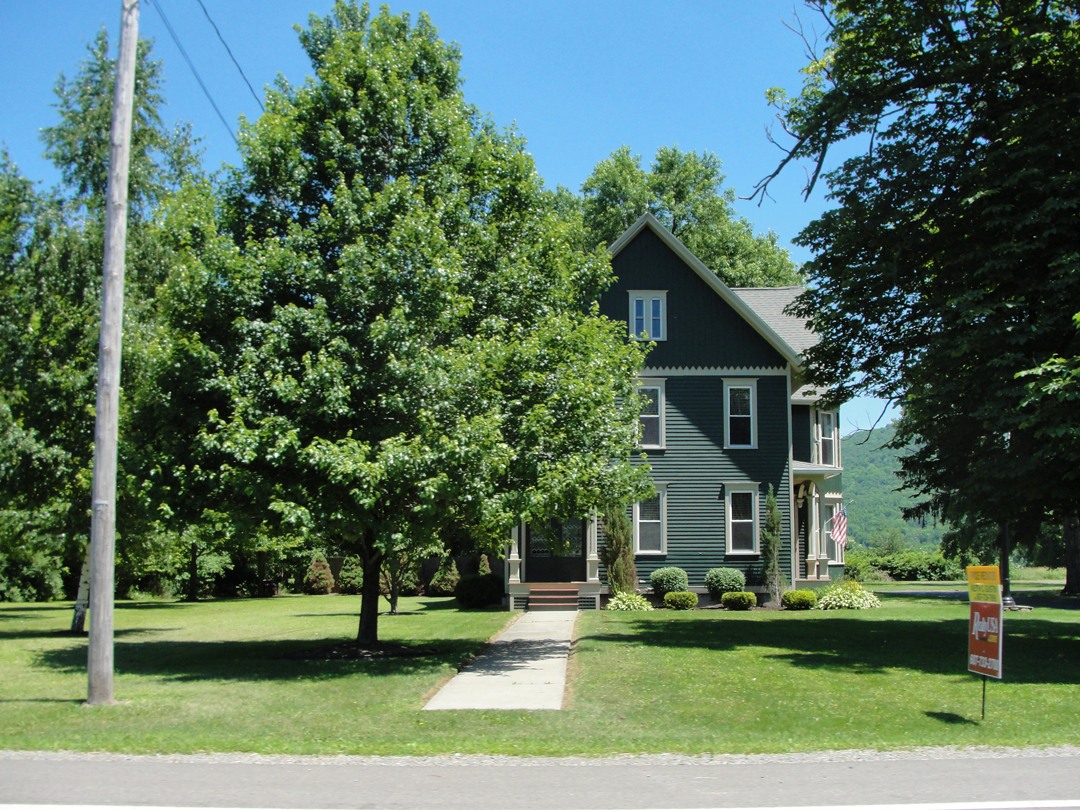
On 352 I passed this house, tucked behind its partial screen of trees, and wondered if the sixty-horse power Pathfinder had passed it similarly.
It's a fair bet that if the house existed on this plot in 1915, the trees did not, save perhaps for the one behind the house - most of the trees I passed on this road were simply not that old by comparison.
Speaking of comparison: Corning's West Market was a-bustle that Saturday mid-day. Treed, clean, and with myriad shops inviting your entry, it was nearly a "night-and-day" change. Maybe because Corning still has Corning - the glass manufacturer. A steady revenue stream makes a huge difference in people's outlook on life.
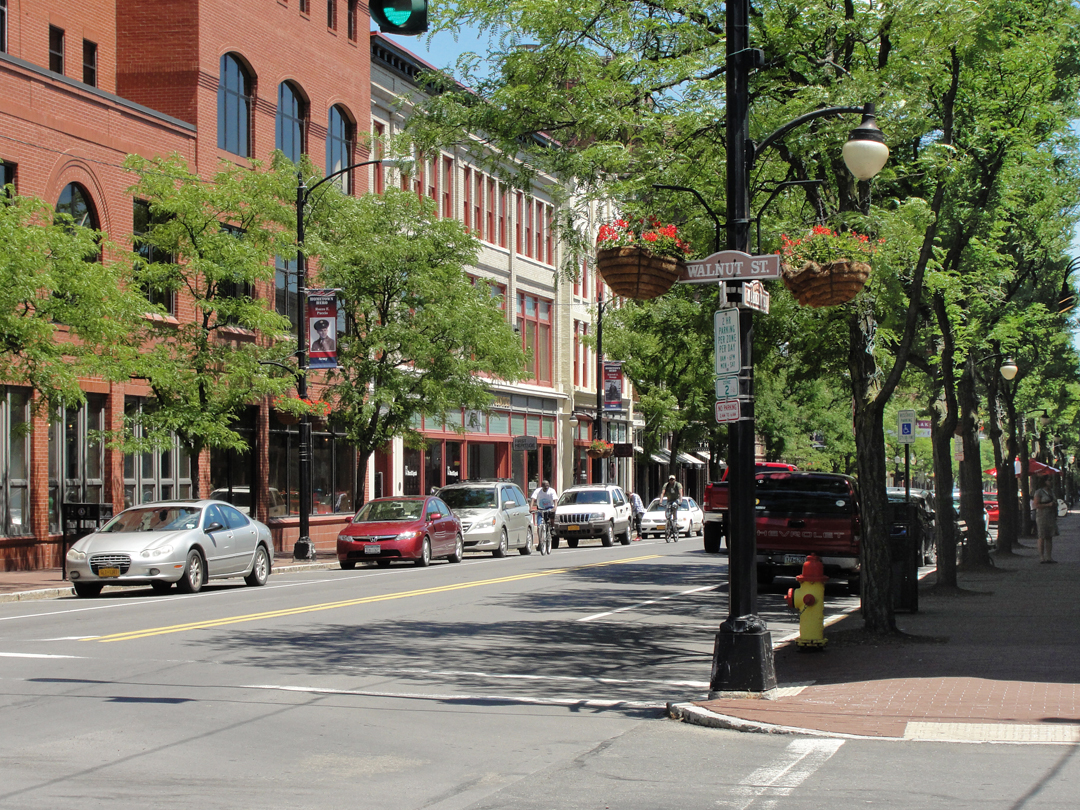

Corning can even boast a bit of "gentrification:" I'm pretty sure this, the T.G. Hawkes & Company building, is only fairly recently home to a glass and craft studio. Though I could be wrong.
All in all, I was favorably impressed with Corning, and maybe what that says about me and my impressions is all too superficial. I suppose there are instances, though, when the impression, the exhibition, does ring true, of a place. Some towns just have a vitality - even just a little - that can make them stand out from the places that, for what-ever reason, have come to have less "pep," less "verve," and maybe it all comes down to why those towns existed. If, for instance, a town came into its own during the hey-day of some commodity, like Youngstown, OH, and steel, when that reason for being is lost, there is not always a way to keep the town afloat in the vast economic sea. Perhaps, as the mayor of Youngstown has lately proposed, the way forward is to dismiss "the way we always did it." Holding to tradition is only good for so long before it becomes nostalgia, and nostalgia does not nourish.
Anyway --

After Corning it was back on the interstate - this time I-390, where, ironically perhaps, I took this photo.
I don't think it was that rest stop 5 miles on, but some other spot some miles farther and noted as a Scenic Turnout that offered this view:
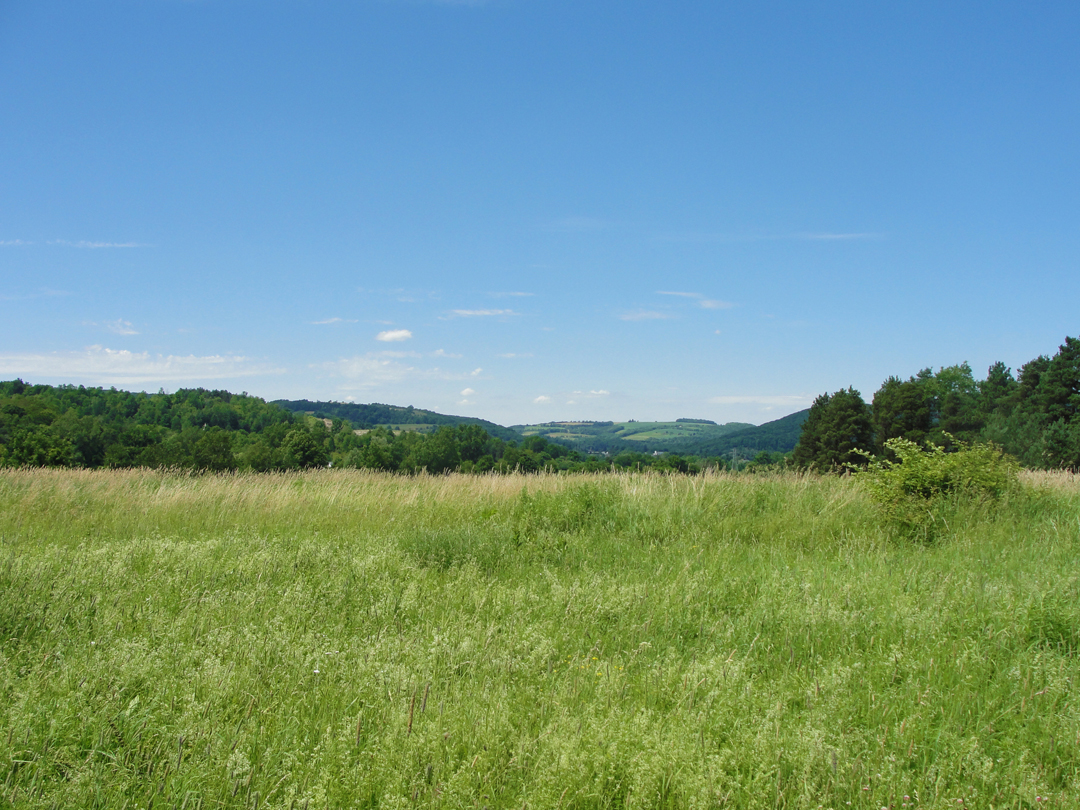
And a few miles more saw my tour removing from the interstate for another state highway, in this case NY 63, preparatory to a left turn for the run to Buffalo. Not far from the interchange with I-390 I had another of those moments of "Wow, I gotta' stop here," because of the view. Not for the first time, I'm sure that the passing traffic had people frowning in wonder at the guy in the hat and tie off to the side of the road. "What's he doin' out there?"
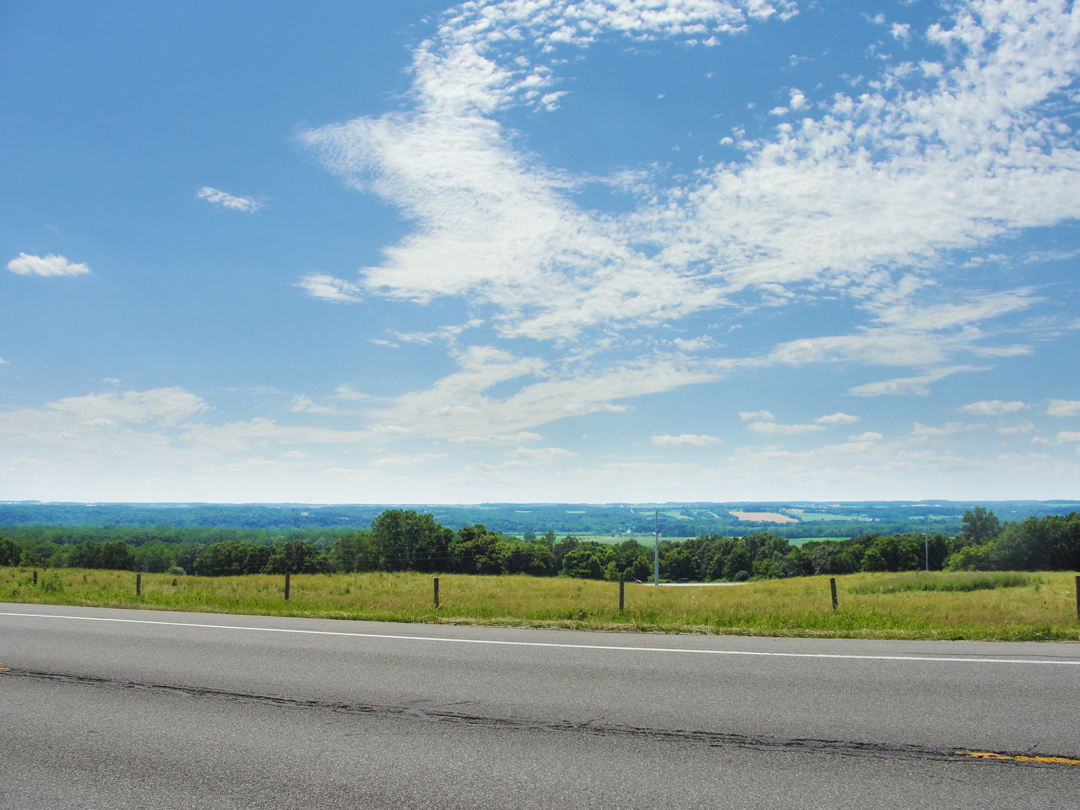
He's taken with the view, which the local populace probably doesn't pay much attention to, unless it's to consider the value. That's a pretty broad - and negative - brush to paint with, I know. Yet I intend to persevere: a sky like this? With that distant hazy vista?
Maybe it's too much for me to say as the photographer what my work is reminiscent of, but occasionally I like to think that all of the art from the Low Countries that I've appreciated, maybe the Hudson Valley School of painting, certainly some of the vistas depicted by painters of the Great American West, have "rubbed off" on my compositions. But that's just me.
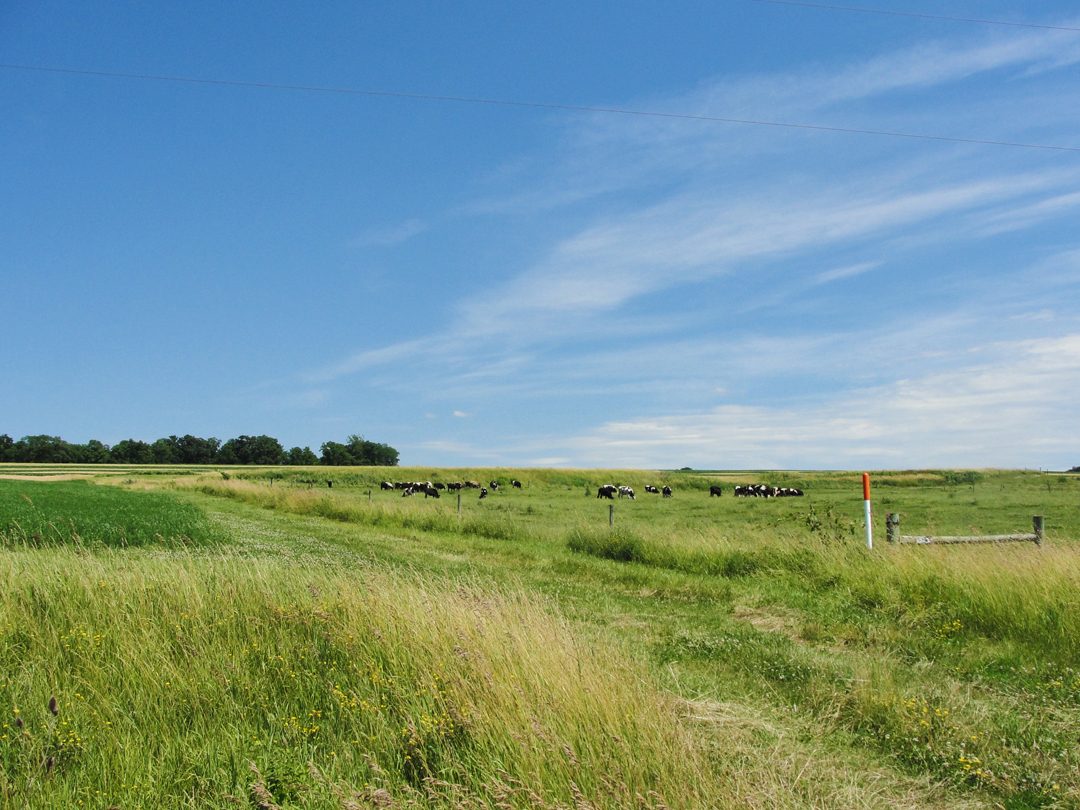
I do even occasionally include wildlife! Well, O.K., not so wild here: only cows.
But note the angle of grassy lane, with the angle of the wispy clouds, the definite fore- mid- and background to the image! The way the dark line of trees balances the open landscape opposite in the frame! The ---
Enough of that.
I only stayed on NY 63 long enough (maybe 5 minutes, minus the photo op) to pick up U.S. 20. Well, I thought it was U.S. 20; I actually turned on to NY 39, which would take me to U.S. 20A. Once turned off 63 though, I figured I'd just stay the course. It was headed toward Buffalo, anyway, so why not? "I'm on vacation!" Along 20A, then; I did pass over and through a lot of pretty country, and found the "Old State Road" taking a rise over a hill, while the "new" road bent around. Reminded of the "Old National Road" in Ohio, I turned back on to the "Old State," and paused where the view opened up.
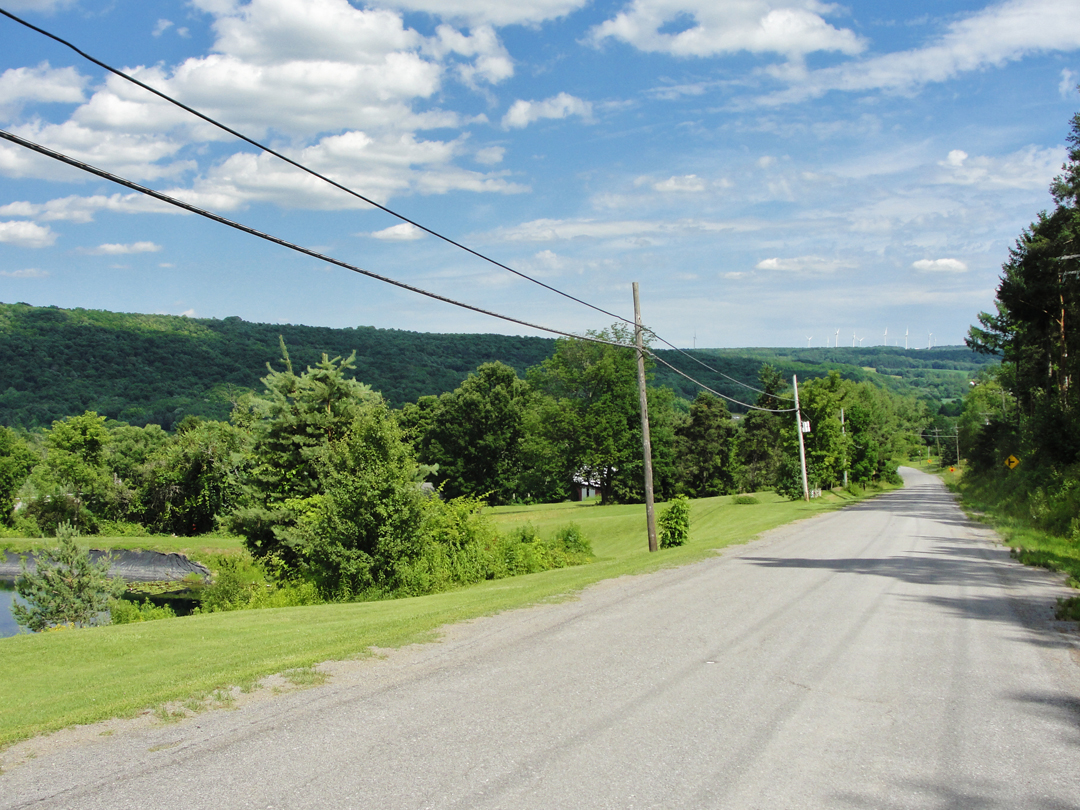
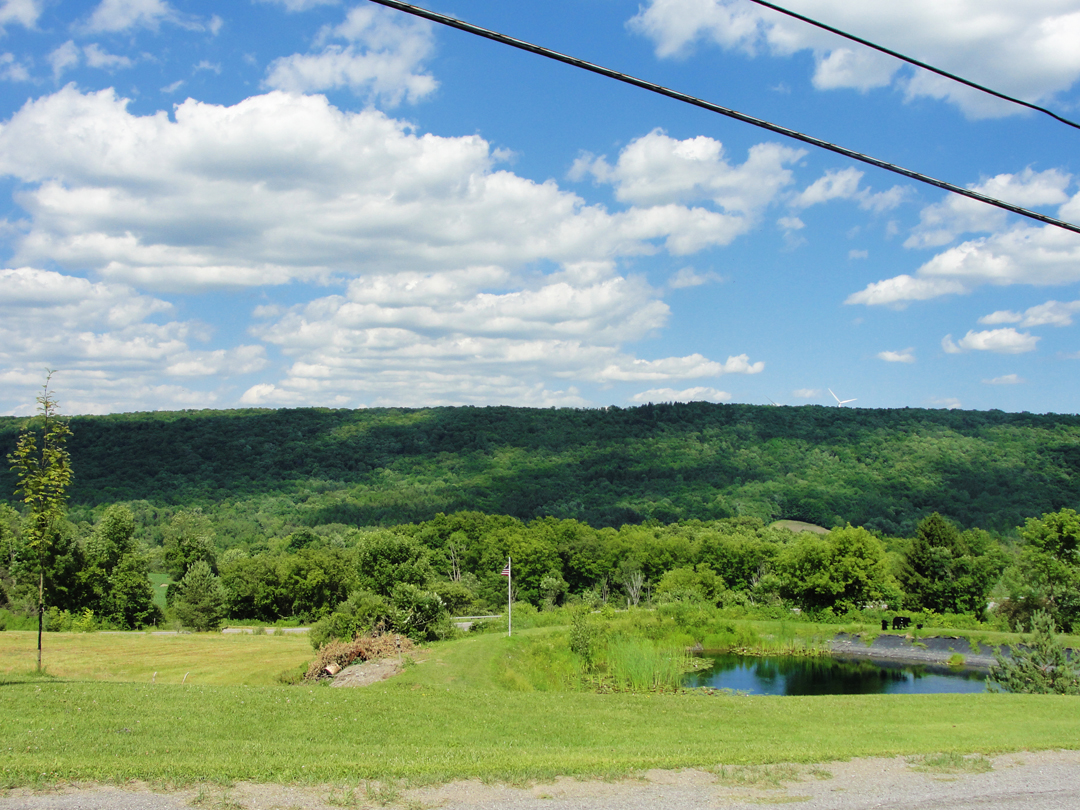
The three Indiana-bound men probably did not pass over this bit of pavement in '15, but surely they would have taken in views like these. This one I shot simply because I liked the shadows of the clouds on the hill opposite.
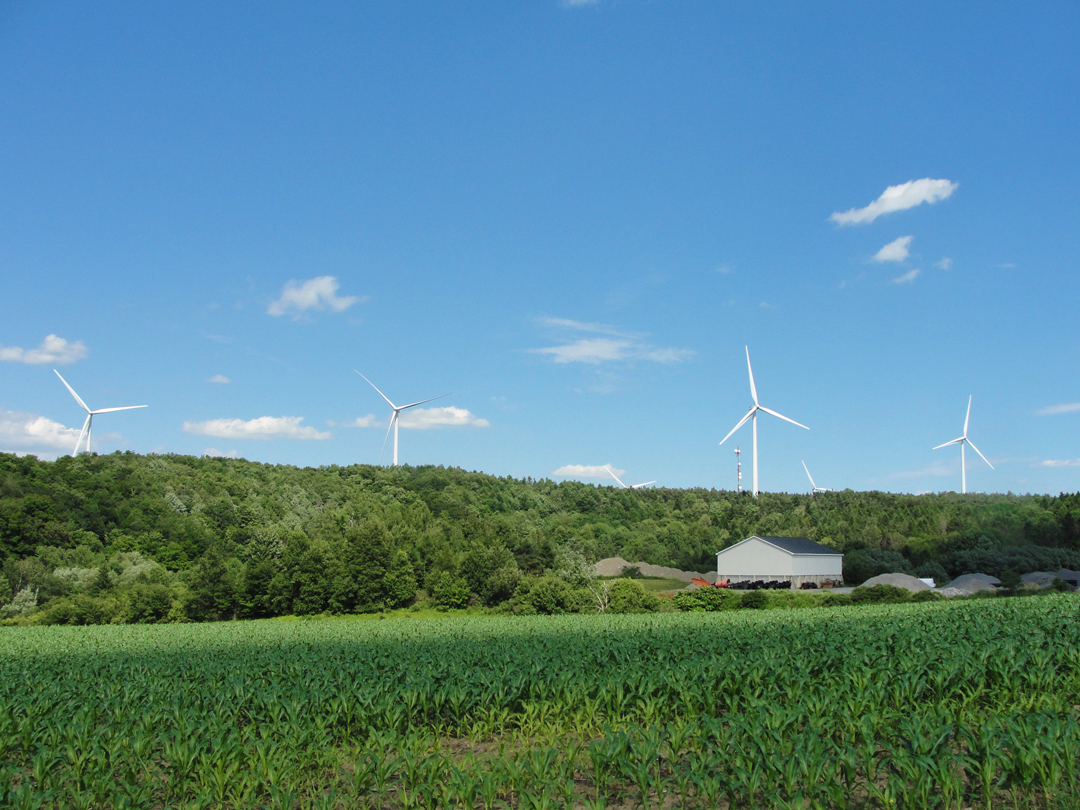
Another view of our modern world, near Orangeville Center:
The Wind Turbine Rising.
Once more passing from the more rural reaches to the urban area, I came to Buffalo on the edge of Lake Erie. What I know of Buffalo is mainly that it suffers from some of the worst of the "lake effect snows" that being so sited it must receive, and that it is yet another example of the "Rust Belt" of America. At one time, it was, along with Cleveland, and Detroit, Pittsburgh and Akron, and other manufacturing centers, a city that had grown in money, and did well until the Rust came.
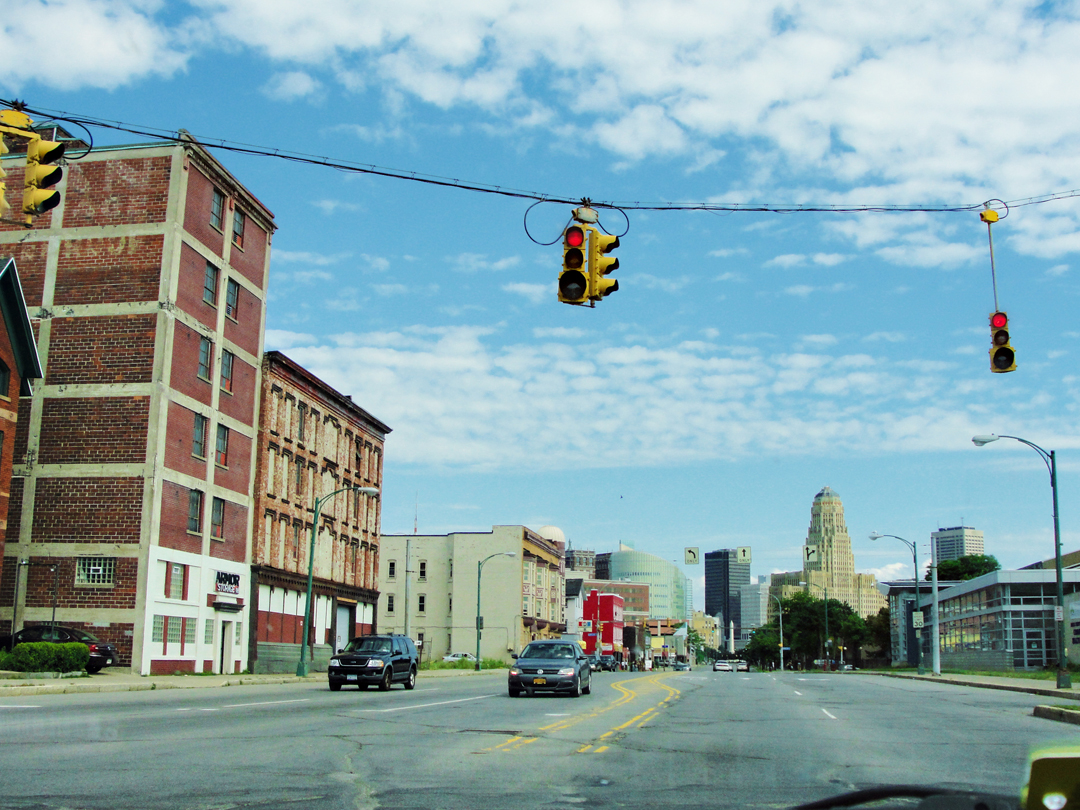
"We are so fine, and yet we are not -- a sort of raw uncouthness showing like shabby woodwork from behind curtains of velvet and cloth of gold. Sometimes, you know, I remember that we are a mongrel race and think we may never achieve anything of great import, so great is my dissatisfaction with the shows and vulgar gaucheries to be seen on all sides. At other times, viewing the upstanding middle class American . . . I want to compose and ode in praise of the final enfranchisement of the common soul. How much better these millions, I ask you, with their derby and fedora hats, their ready made suits, their flaring jewelry, automobiles and a general sense of well being . . . than a race of slaves or serfs . . . ?"
I have also heard it that Buffalo is making its attempts to remake the urban core, giving over the so-called brownfields for reclamation and recreation, making hopeful noise to attract new business enterprises, like so many cities sitting on the knife-edge of reality and history. Alas that not even a mile from that city center, dominated by the Moderne City Hall in the photo above, that striving seemed not quite to have reached. Still alive, yes, but looking for a reason.